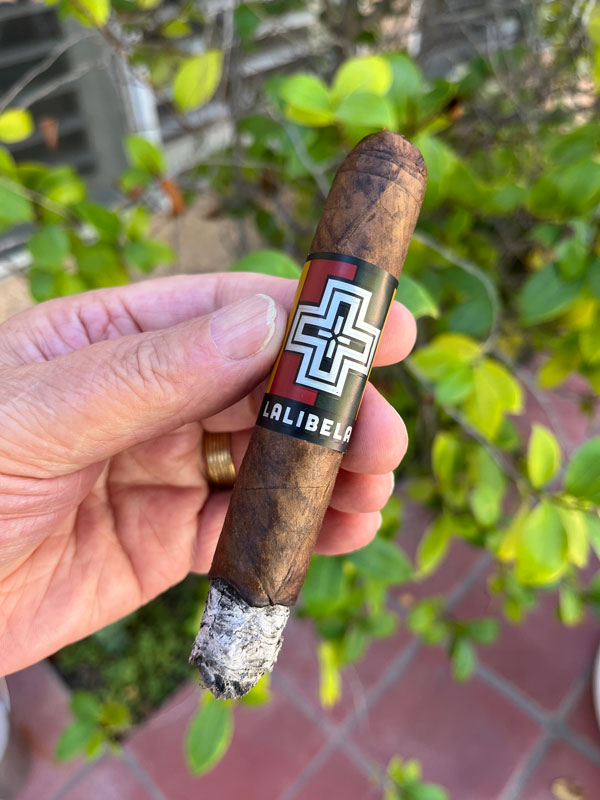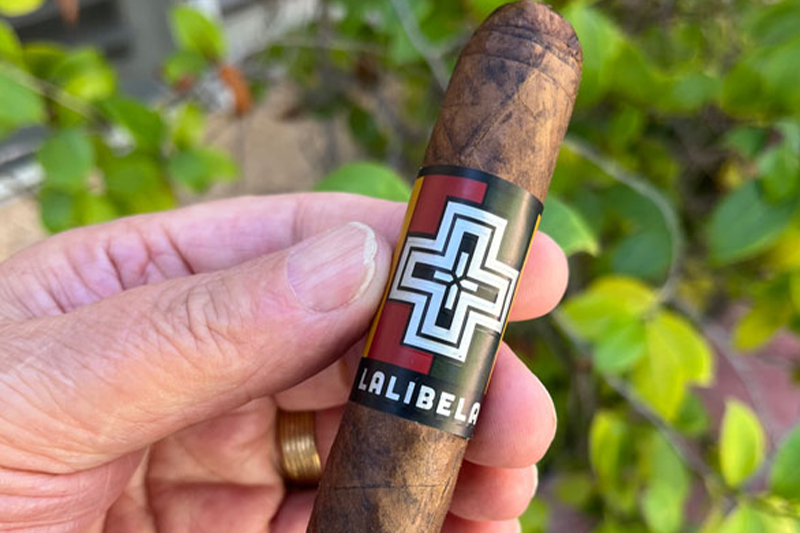It was pretty obvious from the day I received the samples from Black Star Line Cigars which cigar I was going to review. Naturally I fully intended to sample each cigar in the line, and I did. All were excellent, and of high quality, but somehow I knew from the start that Lalibela would be the belle of the ball. Pun intended.
I liked the look of this chunky Toro but had no idea what the name referred to, or how it fit in with brand owner Aric Bey’s ethos of highlighting culturally significant people, places and events with his cigar lines.
A quick Google search revealed Lalibela to be an ancient town in Ethiopia, where Christianity was adopted in the 4th century AD, and a UNESCO World Heritage site. It is famous for its churches, hewn from solid rock, especially the Church of St. George, the best preserved and most skillfully rendered example of the 11 rock churches on the site. Armed with this knowledge I set out to wrest every iota of enjoyment from this imposing yet inviting Corona Gorda with its mystical symbolism.
Appearance: First mention goes to the Lalibela cigar band. It’s eye-catching in a very subtle way: It’s large, but proportional to the cigar. The colors are muted yet they attract the eye, making you notice and evaluate them. Those vertical bands of color are the red, green and yellow of Ethiopia’s flag. Superimposed on them is a blocky cross, with its image repeated in decreasing size in alternating black and silver. That image is the overhead view of the exact shape of the Church of St. George, a marvel of architecture in any age. The name Lalibela is printed in all caps on a black background in matching silver.

The other interesting feature of the cigar band is that it seems to be reversible. Not from the inside out, but from front to back. This became apparent when I realized I was taking photos of the cigar with the reverse of the band showing. Rather than the Lalibela name and cross, I captured the flip side of the band, which is the circular Black Star Line Cigars logo over the same columns of color. I realized my error and featured the name and logo in the subsequent photos. But it looks good either way.
The Lalibela Toro looks bigger than it is. Whether it’s the surplus wrapper folded over the foot of the cigar, the domed, multi-seam cap or the neatly twisted pigtail which looks like a tiny man-bun, the effect is to give the appearance of a cigar measuring 6 3/4 x 54 rather than its 6 x 52 dimensions. The cigar’s weighty heft provides a solid feel in the hand, further contributing to its seemingly larger proportions.
Visually, the Toro is impressive, not in the sense of esthetic beauty, but in its ruddy, rustic, muscular appearance. The San Andrés wrapper is dark and streaky, a matte-textured, deep chocolate-brown, marbled with inky black splotches. The seams are noticeable but unobtrusive. There is one large vein running from the foot to the head on one side of the cigar, but somehow that only adds to its macho appeal. It’s as if the Lalibela Toro is daring me too actually smoke it.
Pre-light aroma: The visual impact barely carries over to the aroma. The wrapper gives off a light, almost delicate scent. There is a noticeably deeper, earthier and more pungent scent from the foot, even with the wrapper leaf covering it. Maybe that’s the frankincense and myrrh from the Church of St. George calling me to worship!
Cold draw: Using my twin-bladed guillotine I slice off just enough of the cap to allow a draw, without exposing a wide swath of filler tobacco. It works; the draw is great, with just enough resistance to prevent me from imbibing so much smoke that I blow the top of my head off.
The flavors released on the cold draw also fail to live up to the cigar’s aggressive image. There is a mildly sweet, cola-like taste, with an earthy undertone, but no pepper, no spices and seemingly no strength.
Initial light: The covered foot is no impediment to my single flame torch, which evaporates the wrapper to reveal the longed-for spicy blast of pepper, tingling the tip of the tongue and the nasal passages, and serving up a hearty portion of full-flavored tobacco. Strength makes its presence known and hints at a barrel-full of body in the next few puffs.
For those who enjoy the enhanced flavors of a retrohale through the nose, be forewarned: This baby packs a punch! A cough will surely follow, as night follows day. Once this is known, one can back off a bit and allow the smoke to gently waft through the palate, layering it with thick clouds of earthy smoke.
First third: I notice the feel of the cigar in my hand is solid, like a wooden dowel. Fortunately, it doesn’t smoke like one. The draw is ideal, just firm enough to prevent an overdose. The flavors are now starting to come on. There seems to be some sweetness emerging, like caramel or toffee. It’s not cloying, rather kind of chewy, like butterscotch. And the pepper is still there as well.
A nice ash is forming, and while the char line is not razor sharp, it’s not really wavy either, just somewhat irregular, but otherwise quite good. The ash is a salt-and-pepper gray and builds up to a nice one-inch stack in the first 15 minutes. At about the 1 1/4” inch mark I gently tap off the ash into the ashtray, and a nice slightly rounded nub of filler is exposed at the foot of the cigar. So far I’m really impressed with the Lalibela.
Second third: I thought this stogie would be all about strength and finesse, but a noticeable transition of flavors emerges. Now I’m getting a syrupy sweetness, again not overt, but a more subtle kind of sweetness contrasting nicely with the spice, which at this point is backing off somewhat. There is also a mineral-like quality which tastes better than it sounds. I also pick up a bit of leather.
The Toro is still looking good, rich and rustic with an impressively straight char line and another solid ash developing, although now in a darker shade of gray. So far there has not been any need for a touch-up, and the Lalibela has not even hinted at going out. This is good construction, along with some artful blending.
Final third: Now I’m getting what I thought this cigar would offer from the very first puffs, a charred oak, roasted meat quality, like an end cut of prime rib—sumptuous within and charred on the outside. There’s no mistaking this smokey, woodsy sensation, as if one were at a barbecue with a beer in one hand and a cigar in the other. That brings to mind what seems to be the perfect pairing for this cigar, a stout, porter or other dark, heavy-bodied beer.
The char line is still good, almost perfectly straight, and a nice thick, gray ash is accumulating. The strength has backed off to medium, with the exception of the retrohales, which still pack a punch.
Finally, after several good-sized ashes have dropped into the ashtray, I’m staring down the final inch or so of this splendid cigar. As a reward, I get a taste of black coffee, something which would come in handy about now, to keep me sharp and alert to the final impressions, and would also make another excellent pairing for this cigar. The Lalibela Toro has provided me with nearly an hour and a half of unadulterated enjoyment, from start to finish.
Final thoughts: This was a terrific cigar. It’s hard to explain, but something about it—the look, the feel, the heft, whatever it is—made this a fun cigar to smoke, beyond the typical metrics of flavor, strength and construction. It was just an entertaining cigar to look at, savor and enjoy, and even the band made me feel good about my selection. This is a cigar I would come back to frequently. Per the Black Star Line website, Lalibela is also available in a 6 inch by 60 ring gauge Gordo. I’m putting that on my bucket list.
My only caveat here would be, newbies beware. Ease into this with one of the other excellent offerings from this up-and-coming, socially conscious brand. They’re going to be around for the long haul.
Black Star Line Lalibela
- Size: 6 x 52, Toro
- Wrapper: San Andrés Maduro
- Binder: Nicaraguan
- Filler: Nicaraguan
- Country of Origin: Nicaragua
- MSRP: $12.50
- Smoking time: 1 hour, 20 minutes
- Release date: March 2021
– Photos and review by Larry Wagner. Opening photo courtesy of Black Star Line Cigars. Samples provided by Black Star Line Cigars.
This story first appeared in PCA The Magazine, Volume 4, 2023. To receive a copy of this magazine, you must be a current member of PCA.

